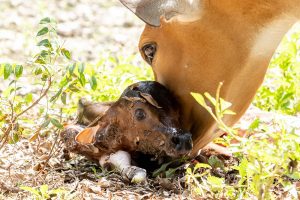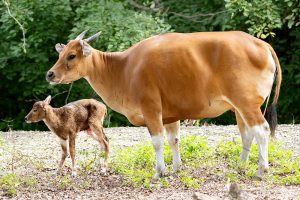|
Getting your Trinity Audio player ready...
|
One never knows what they may see during a visit to Zoo Miami. Today, at approximately 1:00PM, some guests were rewarded with an extra special treat as they were privileged to observe the birth of an endangered banteng!

Early this afternoon, while still in her habitat, the mother, named “Phyllis,” went into labor and proceeded to give birth as visitors watched in amazement! This was a nervous time for zoo staff because when animals go into labor, they are provided access to their secluded off-exhibit areas. However, Phyllis decided that she wanted to have her baby in front of the public! And so it was!
She calmly laid down and after several pushes, the baby emerged to the delight of the observers! She promptly cleaned the newborn as it took its first breaths. After several unsuccessful attempts, and with a little help from mom, the infant finally stood up on its long shaky legs. Mom was very attentive as she continued to methodically clean the calf. Soon, the baby had found its way to mom’s nipples and proceeded to nurse.

Though the calf appears to be healthy, zoo staff is being cautiously optimistic. This is because Phyllis has given birth twice before, and sadly, both of the calves were stillborn. There will be a neonatal exam done on the newborn within the next 24-48 hours when the Animal Health Team will then be able to positively identify the sex of the calf as well as perform a series of exams to help ensure that it is healthy.
Bantengs are a highly endangered wild cow found in isolated areas of Southeast Asia and Indonesia where there are believed to be less than 8,000 left in the wild. Their biggest threats are habitat loss and hunting as well as the introduction of disease from domestic cattle that often are introduced to their native habitat for grazing. Born with red coats, they soon develop white stockings and rumps within their first year. Males will eventually change from a chestnut red color to an almost black color when they reach sexual maturity.





